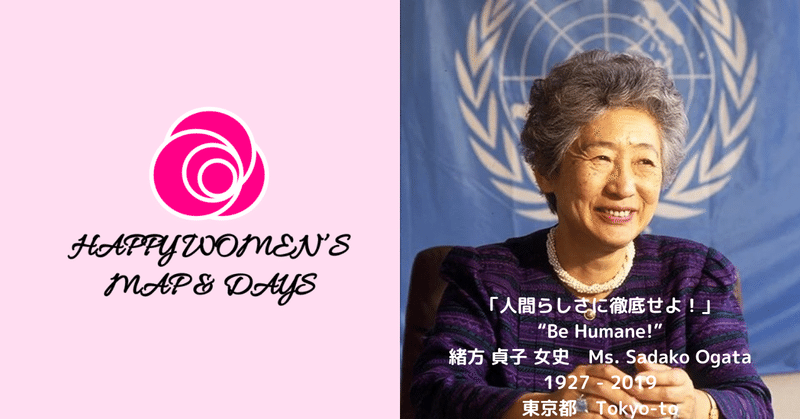
Happy Women's Map 東京都 女性初の国連難民高等弁務官、JICA初代理事長 緒方 貞子 女史

「人間らしさに徹底せよ!」
"Be Humane!"
緒方 貞子 女史
Ms. Sadako Ogata
1927 - 2019
東京都麻布区 生誕
Born in Asabu-ku, Tokyo-to
緒方 貞子 女史は女性初の日本女性初の国連日本政府代表部公使、女性初の国連難民高等弁務官、JICAの初代理事長、日本における模擬国連活動の創始者です。難民救済と人間の安全保障のために世界中を駆け巡りました。
Ms. Sadako Ogata was the first woman in Japan to serve as the Ambassador of Japan to the United Nations, the first female UN High Commissioner for Refugees, the inaugural Chairperson of JICA (Japan International Cooperation Agency), and the founder of Model United Nations activities in Japan. She has been tirelessly working around the world for refugee relief and human security.
********
「私の友達がいた国が何であんなことをするようになったのだろう」
貞子は外交官の家庭に育ち、米国、中国で幼少期を過ごします。4歳のとき、曽祖父・犬養毅の突然の死をサンフランシスコで知ります。「軍部はよほど悪い人たちに違いない」。身体を動かすことが大好きなおてんばで、いちばん楽しみなのは運動会。長距離は苦手でも短距離は得意中の得意。外をたくさん走り回って活発に過ごしていると、日中戦争が勃発、勝手に歩き回ることさえできなくなります。8歳の時に一家で帰国、まもなく日米戦争が始まって空襲で焼き出され、疎開先の軽井沢で終戦を迎えます。聖心女子大学入学すると、午前中に授業をすませて午後はテニスに打ちこみます。初代学長キャサリン・エリザベス・T・ブリットから女性としてリーダーシップをとるよう背中を押され、米ジョージタウン大やカリフォルニア大バークレー校の大学院で学びます。「一体日本はどういう国だったのだろうか、どうしてああいう戦争になったのだろうか」、満州事変に関わる政策決定過程について論文を書いて政治学の博士号を取得します。その最中に、後の日本銀行理事・緒方四十郎と結婚。夫に伴って大阪・ロンドンで子育てに奔走、しばらくして国際基督教大学の非常勤講師として外交史の教鞭をとります。1週間に1日の講義のために、家事を終えて子供を寝かしつけた後に毎日猛勉強します。ある日、市川房枝女史が突然訪ねてきて、「どうしても行ってほしい」、強い推薦により国連総会の日本政府代表団に参加、女性初の国連日本政府代表部公使に起用されます。子育て中でためらう貞子に、「みんなでやれば何とかなるから、行きなさい」父と夫も全面的にバックアップします。
「一番大事なことは苦しんでいる人間を守り、彼らの苦しみを和らげること」
貞子は国連総会の中の人権委員会の特別報告者として、軍事政権のもとで人権侵害が非常に大きいと考えられていたビルマ(現在のミャンマー)に人権交渉に向かいます。さらに、上智大学教授として研究をしながら、日本政府カンボジア難民救済実情視察団団長としてタイ国境の難民キャンプを視察します。その頃、日本からの拠出金ならびに日本人女性への期待が高まり、64歳の貞子は1991年に第8代国連難民高等弁務官にアジア初・女性初として就任、さらに2度再任され10年間にわたって従事します。貞子は難民問題を抱える紛争地を防弾チョッキ・ヘルメットで積極的に訪れる「現場主義」を貫きます。1年の半分は現地で過ごしながら、難民たちがどんな経験をしてここに至ったのかを理解するために、ひたすら彼らの声に耳を傾け、さらに地域の政治的なリーダーとも交渉します。湾岸戦争では、「内政干渉」と反対する各国外交官を説得して回って、トルコへの入国を拒否されイラク国内にとどまるクルド人を国内避難民として支援します。ボスニア紛争では、国連安全保障理事会から厳しい批判を浴びながらも人道支援の政治利用を断固拒否、サラエボへ食料の空輸を決行します。ルワンダ内戦では、武装集団だった人々を支援することに避難を浴びながらも、 アフリカ諸国の協力による治安維持軍を組織、「和解」と「共生」のために難民の武装解除をしながらルワンダ難民を母国に強制送還します。それから貞子はボスニアならびにルワンダで女性を中心とした様々なグループの出会いの場(難民と非難民、対立する民族同士など含む)、いろいろな職業訓練の場、ならびに新しい社会作りの中心勢力として「ボスニア女性イニシアチブ」「ルワンダ女性イニシアチブ」を組織します。
「1人だけよくなる時代はもうあり得ない」
貞子が難民高等弁務官時代にいちばん多くの難民を発生させた国アフガニスタンからは、600万人が周辺のパキスタン・イランに流出。アフガンの難民のための支援金が毎年減っていく中、貞子はタリバン側に女子の教育また女性の就業に努力してほしいという交渉をしにいきますが、なかなか国際的な支援は得られません。アフガニスタンは「忘れられた国」となっている状況で9月11日にニューヨークでテロが起こります。その後、かなりのタリバンが追放されると難民400万人は帰っていきます。2000年に約10年間務めた国連難民高等弁務官を退任すると、小泉純一郎政権で、アフガニスタン戦争後の支援政府特別代表に就任。貞子は難民の人たち、ならびにアフガン側と交渉、受け入れのための地域をつくるなど調整に動きます。2002年に東京で最初のアフガン復興支援国際会議が開催され、貞子はカルザイ暫定政権議長(後の大統領)とともに共同議長を務めます。貞子は、文民が中心になった支援をしてきた日本はじめ、オバマ政権のアメリカ、それを支援してきた多くのヨーロッパの国々、また関心をもっている国々との間のいろいろな話し合いを調整します。地元警察によって治安をおさえると同時に、復興援助によって少しでもいい生活ができる可能性を人々に分かってもらえるよう尽力します。2003年に新たに発足したJICAの初代理事長に就任。「開発援助による復興支援というのはなんて遅いものなんだろう」危険に対応するいろいろな訓練をしたうえで、防弾車を広範囲に使いながら、若手をいち早く開発途上国の現場に送り込みます。晩年もテニスに打ち込みつつ世界を駆け巡りながら92歳で逝去。
"Why did the country where my friend used to live start doing such things?"
Sadako was raised in a diplomatic family and spent her early childhood in the United States and China. At the age of 4, she learned about the sudden death of her great-grandfather, Tsuyoshi Inukai, while in San Francisco. "The military must be really bad people." She was a lively and active girl who loved physical activity, with her favorite event being the sports festival. She wasn't great at long-distance running, but she excelled in short sprints. However, as she was running around outside and enjoying her active life, the Second Sino-Japanese War began, and she could no longer roam freely. When she was 8 years old, her family returned to Japan, and shortly afterward, the Pacific War began. Their house was burned down during an air raid, and she spent the end of the war in Karuizawa, where they had evacuated. Upon entering Seishin Women's University, she completed her classes in the morning and spent her afternoons playing tennis. She received encouragement from the university's first president, Catherine Elizabeth T. Britton, to take on leadership roles as a woman. She pursued further studies at Georgetown University and the University of California, Berkeley. While studying, she wrote a thesis on the decision-making process related to the Manchurian Incident and obtained a Ph.D. in political science. During this time, she married Sōtarō Ogata, who would later become a director of the Bank of Japan. She supported her husband as he worked in Osaka and London while raising their children. Afterward, she took on a part-time lecturing role at the International Christian University and taught diplomatic history. She would prepare for her lectures daily after taking care of household chores and putting her children to bed. One day, Fusae Ichikawa unexpectedly visited her and said, "I really want you to go." Thanks to Ichikawa's strong recommendation, Sadako joined the Japanese government delegation to the United Nations General Assembly and became the first female Minister at the Japanese Mission to the United Nations. Although she was initially hesitant due to her responsibilities at home, her father and husband offered their full support, telling her, "If everyone works together, things will be alright. You should go."
"The most important thing is to protect those who are suffering and alleviate their suffering."
Sadako, as a special rapporteur for the United Nations Human Rights Commission, headed for Burma (now Myanmar), where significant human rights abuses were believed to occur under the military regime. Furthermore, while working as a professor at Sophia University, she led the Japanese government's Cambodia Refugee Relief Survey Mission to inspect refugee camps on the Thai border. At that time, due to increased contributions from Japan and high expectations for Japanese women, Sadako, at the age of 64, was appointed as the 8th United Nations High Commissioner for Refugees (UNHCR), making her the first woman from Asia and the first woman in the role. She was reappointed twice and served for a total of 10 years. Sadako was a proponent of the "field-oriented" approach, actively visiting conflict-ridden areas with body armor and helmets to understand how refugees arrived there by intently listening to their stories and negotiating with local political leaders. Half of her time was spent in the field. In the Gulf War, she persuaded diplomats from various countries opposed to "interference in domestic affairs" to allow Kurdish people who were denied entry into Turkey to stay in Iraq as internally displaced people. During the Bosnian conflict, despite facing strong criticism from the United Nations Security Council, she firmly refused to use humanitarian assistance for political purposes and organized the airlift of food to Sarajevo. In the Rwandan Civil War, despite the fact that she was targeted for sheltering armed groups, she organized a peacekeeping force with the cooperation of African nations, disarmed Rwandan refugees, and forcibly repatriated them to their home country in the name of "reconciliation" and "coexistence." Afterward, Sadako established various initiatives, such as the "Bosnia Women's Initiative" and the "Rwanda Women's Initiative," serving as meeting places for women, including refugees and non-refugees, as well as groups of different ethnic backgrounds. These initiatives provided various vocational training programs and played a central role in building new societies.
"An era where only one person improves is no longer possible."
During her time as the United Nations High Commissioner for Refugees, Sadako dealt with the largest number of refugees from Afghanistan, where around 6 million people fled to neighboring countries such as Pakistan and Iran. While international support for Afghan refugees was decreasing every year, Sadako made efforts to negotiate with the Taliban, urging them to prioritize girls' education and women's employment. However, obtaining international support for this cause proved challenging. Afghanistan became a "forgotten country" in a situation where very little attention or aid was provided. Then, on September 11, a terrorist attack occurred in New York City. Subsequently, after the expulsion of a significant number of Taliban members, around 4 million refugees began returning to Afghanistan. Sadako stepped down from her role as the United Nations High Commissioner for Refugees, which she held for nearly a decade, in 2000. During the administration of Prime Minister Junichiro Koizumi, she became a special representative of the Japanese government for post-Afghanistan war support. She engaged in negotiations with the Afghan side, worked to establish areas for their reception, and coordinated various efforts. In 2002, the first international conference for the reconstruction of Afghanistan was held in Tokyo. Sadako, alongside Hamid Karzai, who was the chairman of the interim government (later the president), served as co-chair of the conference. She played a pivotal role in mediating discussions between Japan and other countries, including the United States under the Obama administration, which had provided support, and various European nations. She worked to adjust various aspects of discussions, from local police for maintaining security to encouraging people to understand the possibilities of a better life through reconstruction assistance. In 2003, she became the inaugural director of the Japan International Cooperation Agency (JICA). Despite the challenges, she sent young personnel to the field in developing countries using armored vehicles extensively and provided various training programs to cope with dangers.
Even in her later years, she continued to play tennis and traveled the world, passing away at the age of 92.
-聖心女子大学 University of Sacred Heart, Tokyo
-国連難民高等弁務官事務所 The UN Refugee Agency
-国際協力機構 JICA
-日本模擬国連 JMUN

Share Your Love and Happy Women's Story!
あなたを元気にする女性の逸話をお寄せください!
Share your story of a woman that inspires you!
この記事が気に入ったらサポートをしてみませんか?
